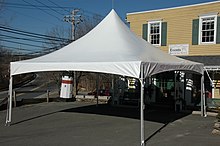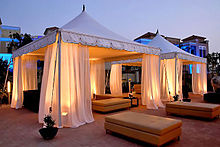
A tent is a shelter consisting of sheets of fabric or other material draped over, attached to a frame of poles or a supporting rope. While smaller tents may be free-standing or attached to the ground, large tents are usually anchored using guy ropes tied to stakes or tent pegs. First used as portable homes by nomads, tents are now more often used for recreational camping and as temporary shelters.

A campervan, also referred to as a camper, caravanette, motorhome or RV in North America, is a self-propelled vehicle that provides both transport and sleeping accommodation. The term describes vans that have been fitted out, whereas a motorhome is one with a coachbuilt body.

A gazebo is a pavilion structure, sometimes octagonal or turret-shaped, often built in a park, garden, or spacious public area. Some are used on occasions as bandstands.

A bed is an item of furniture that is used as a place to sleep, rest, and relax.

A wigwam, wikiup, wetu (Wampanoag), or wiigiwaam is a semi-permanent domed dwelling formerly used by certain Native American tribes and First Nations people and still used for ceremonial events. The term wikiup is generally used to refer to these kinds of dwellings in the Southwestern United States and Western United States and Northwest Alberta, Canada, while wigwam is usually applied to these structures in the Northeastern United States as well as Ontario and Quebec in central Canada. The names can refer to many distinct types of Indigenous structures regardless of location or cultural group. The wigwam is not to be confused with the Native Plains tipi, which has a different construction, structure, and use.

A tonneau is an area of a car, truck, or boat open at the top. It can be for passengers or cargo. When applied to trucks it refers to their bed or tray.

A toolbox is a box to organize, carry, and protect the owner's tools. They could be used for trade, a hobby or DIY, and their contents vary with the craft.
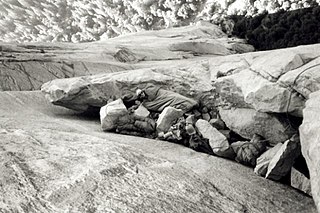
A bivouac shelter or bivvy is any of a variety of improvised camp site or shelter that is usually of a temporary nature, used especially by soldiers or people engaged in backpacking, bikepacking, scouting or mountain climbing. It may often refer to sleeping in the open with a bivouac sack, but it may also refer to a shelter constructed of natural materials like a structure of branches to form a frame, which is then covered with leaves, ferns and similar material for waterproofing and duff for insulation. Modern bivouacs often involve the use of one- or two-person tents but may also be without tents or full cover. In modern mountaineering the nature of the bivouac shelter will depend on the level of preparedness, in particular whether existing camping and outdoor gear may be incorporated into the shelter.

Formwork is molds into which concrete or similar materials are either precast or cast-in-place. In the context of concrete construction, the falsework supports the shuttering molds. In specialty applications formwork may be permanently incorporated into the final structure, adding insulation or helping reinforce the finished structure.

A marquee is most commonly a structure placed over the entrance to a hotel, theatre, casino, train station, or similar building. It often has signage stating either the name of the establishment or, in the case of theatres, the play or movie and the artist(s) appearing at that venue. The marquee is sometimes identifiable by a surrounding compound of light bulbs, usually yellow or white, that flash intermittently or as chasing lights.

An awning or overhang is a secondary covering attached to the exterior wall of a building. It is typically composed of canvas woven of acrylic, cotton or polyester yarn, or vinyl laminated to polyester fabric that is stretched tightly over a light structure of aluminium, iron or steel, possibly wood or transparent material. The configuration of this structure is something of a truss, space frame or planar frame. Awnings are also often constructed of aluminium understructure with aluminium sheeting. These aluminium awnings are often used when a fabric awning is not a practical application where snow load as well as wind loads may be a factor.

A residential garage is a walled, roofed structure with a door for storing a vehicle or vehicles that may be part of or attached to a home, or a separate outbuilding or shed. Residential garages typically have space for one or two cars, although three-car garages are used. When a garage is attached to a house, the garage typically has an entry door into the house, called the person door or man door, in contrast with the wider and taller door for vehicles, called the garage door, which can be opened to permit the entry and exit of a vehicle and then closed to secure the vehicle. A garage protects a vehicle from precipitation, and, if it is equipped with a locking garage door, it also protects the vehicle(s) from theft and vandalism. Most garages also serve multifunction duty as workshops for a variety of projects, including painting, woodworking, and assembly. Garages also may be used for other purposes as well, such as storage or entertainment.
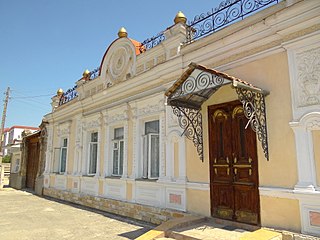
A canopy is a type of overhead roof or else a structure over which a fabric or metal covering is attached, able to provide shade or shelter from weather conditions such as sun, hail, snow and rain. A canopy can also be a tent, generally without a floor. The word comes from the ancient Greek κωνώπειον, from κώνωψ, which is a bahuvrihi compound meaning "mosquito". The first 'o' changing into 'a' may be due to influence from the place name Canopus, Egypt thought of as a place of luxuries.
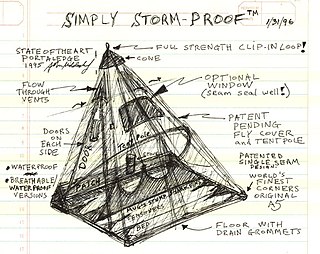
A portaledge is a deployable hanging tent system designed for rock climbers who need to spend multiple days and nights on a climbing route suspended from a sheer rock face while big wall climbing. A fully assembled portaledge is a fabric-covered platform surrounded by a metal frame that hangs from a single anchor point via carabiners and has adjustable suspension straps. A separate cover—called a stormfly—covers the entire system to give protection in the event of bad weather. The first portaledges were created for climbing in Yosemite.

The Volkswagen Westfalia Camper was a conversion of the Volkswagen Type 2, and then, the Volkswagen Type 2 (T3), sold from the early 1950s to 2003. Volkswagen subcontracted the modifications to the company Westfalia-Werke in Rheda-Wiedenbrück.

A Rubb Hall is a commercial name for particularly large, relocatable tent-like structure often used in situations of emergency and temporary industry. The name derives from Rubb Building Systems, and Hall Engineering of Bergen Norway, manufacturers of this kind of structure. Other types of similar structure include HAGUHALL.

Tension fabric buildings or tension fabric structures are constructed using a rigid frame—which can consist of timber, steel, rigid plastic, or aluminum—and a sturdy fabric outer membrane. Once the frame is erected, the fabric cover is stretched over the frame. The fabric cover is tensioned to provide the stable structural support of the building. The fabric is tensioned using multiple methods, varying by manufacturer, to create a tight fitting cover membrane.
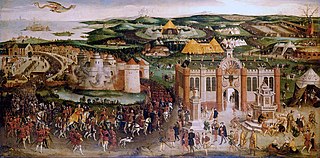
A pole marquee or pole tent is a variety of large tent often used to shelter summer events such as shows, festivals, and weddings. They are particularly associated with typical English country garden weddings and village fetes.

Pipe and drape is a style of freestanding panelling used to divide, hide, and/or decorate a space temporarily. The structure consists of aluminum or steel piping fixed or adjustable telescoping vertical uprights supported by a weighted steel base, and adjustable telescopic or fixed horizontals that provide a drape support frame with removable drape panels.
